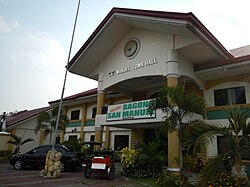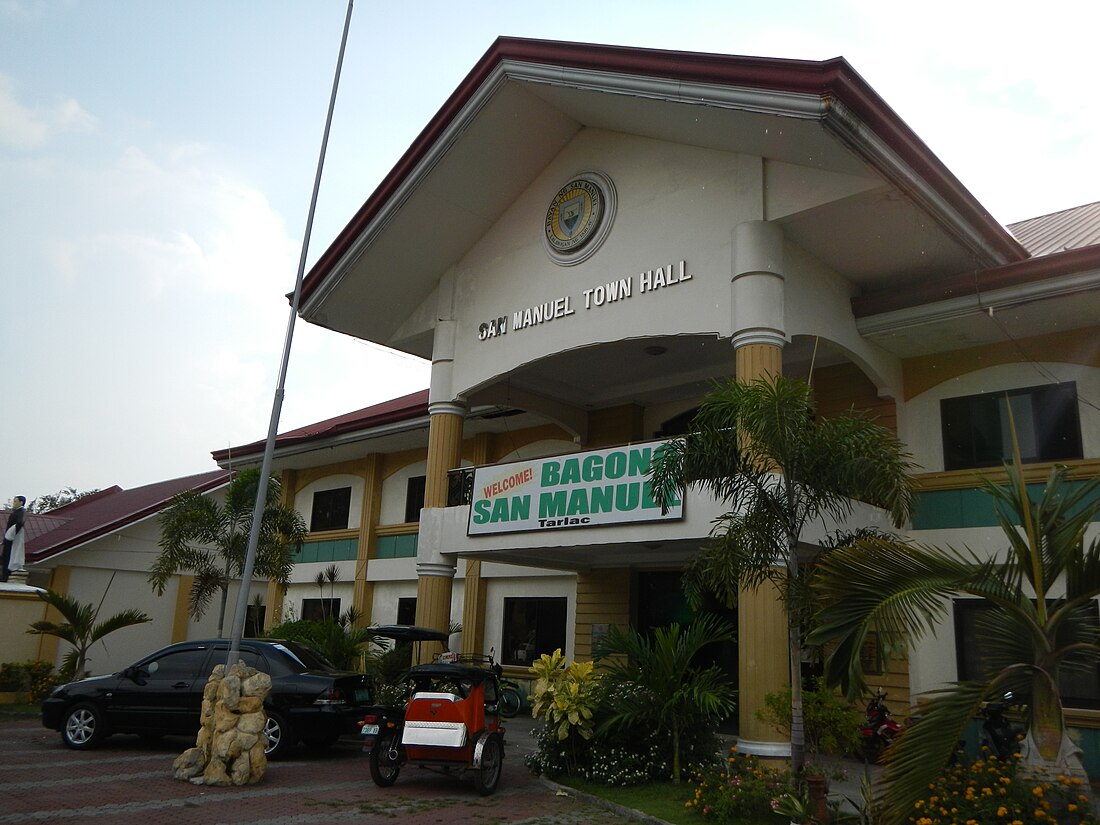San Manuel, Tarlac
Municipality in Tarlac, Philippines From Wikipedia, the free encyclopedia
San Manuel, officially the Municipality of San Manuel (Ilocano: Ili ti San Manuel; Pangasinan: Baley na San Manuel; Tagalog: Bayan ng San Manuel), is a municipality in the province of Tarlac, Philippines. According to the 2020 census, it has a population of 28,387 people.[3]
San Manuel | |
|---|---|
| Municipality of San Manuel | |
 Municipal Hall | |
| Nickname: Logistics Hub of the North | |
| Motto(s): Sulong pa, Bagong San Manuel! | |
 Map of Tarlac with San Manuel highlighted | |
Location within the Philippines | |
| Coordinates: 15°47′51″N 120°36′26″E | |
| Country | Philippines |
| Region | Central Luzon |
| Province | Tarlac |
| District | 1st district |
| Founded | February 25, 1902 |
| Barangays | 15 (see Barangays) |
| Government | |
| • Type | Sangguniang Bayan |
| • Mayor | Doña Cresencia R. Tesoro |
| • Vice Mayor | Atty. Sir Benjamin R. Tesoro |
| • Representative | Jaime D. Cojuangco |
| • Electorate | 18,075 voters (2025) |
| Area | |
• Total | 42.10 km2 (16.25 sq mi) |
| Elevation | 24 m (79 ft) |
| Highest elevation | 59 m (194 ft) |
| Lowest elevation | 15 m (49 ft) |
| Population (2020 census)[3] | |
• Total | 28,387 |
| • Density | 670/km2 (1,700/sq mi) |
| • Households | 7,000 |
| Economy | |
| • Income class | 4th municipal income class |
| • Poverty incidence | 14.06 |
| • Revenue | ₱ 292.6 million (2022) |
| • Assets | ₱ 661.9 million (2022) |
| • Expenditure | ₱ 247.6 million (2022) |
| • Liabilities | ₱ 100.3 million (2022) |
| Service provider | |
| • Electricity | Tarlac 1 Electric Cooperative (TARELCO 1) |
| Time zone | UTC+8 (PST) |
| ZIP code | 2309 |
| PSGC | |
| IDD : area code | +63 (0)45 |
| Native languages | Pangasinan Ilocano Tagalog Kapampangan |
| Website | www |
History
When the barrio of San Jose was separated from the town of Moncada to be proclaimed a sister municipality in 1909, they renamed it “San Manuel” in honor of their benefactor, Don Manuel de Leon.
San Manuel was originally covered with dense forest, lakes and creeks. Wild animals roamed into the wilderness. Settlers from Zambales and Pangasinan - and later those from the Ilocos Region - inhabited into the area to start a new life.
The residents of this barrio then did not know which jurisdiction they belonged. There are four towns surrounding the area namely: Moncada in the south; Anao and Cuyapo in the east and Alcala in the north. Neither of these duly organized municipalities claimed the sprawling area. However, an incident in the barrio helped the people solved the “jurisdiction” problem. A man gathering bees fell from the tree and died. The people immediately reported the incident to the nearby localities but only the Moncada authorities came and investigated the incident. Spurred by the gestures of the people of that town, they joined and submitted themselves under their jurisdiction and finally became an integral part of Moncada.
Geography
Summarize
Perspective
The Provinces of Pangasinan and Nueva Ecija border it to the north and east, respectively; while the municipalities of Anao and Moncada border the town to the south.
From Manila, the town is accessible via the MacArthur Highway, or via the NLEX (North Luzon Expressway), SCTEX (Subic-Clark-Tarlac Expressway) and TPLEX (Tarlac–Pangasinan–La Union Expressway); it is the last town of Tarlac before entering the town of Rosales in the province of Pangasinan.
San Manuel is 161 kilometres (100 mi) from Manila and is 37 kilometres (23 mi) from the provincial capital, Tarlac City.
Barangays
San Manuel is politically subdivided into 15 barangays, as shown below. [5] Each barangay consists of puroks and some have sitios.
- Colubot
- Lanat
- Legaspi
- Mangandingay
- Matarannoc
- Pacpaco
- Poblacion
- Salcedo
- San Agustin
- San Felipe
- San Jacinto
- San Miguel
- San Narciso
- San Vicente
- Santa Maria
Climate
| Climate data for San Manuel, Tarlac | |||||||||||||
|---|---|---|---|---|---|---|---|---|---|---|---|---|---|
| Month | Jan | Feb | Mar | Apr | May | Jun | Jul | Aug | Sep | Oct | Nov | Dec | Year |
| Mean daily maximum °C (°F) | 30 (86) |
31 (88) |
33 (91) |
34 (93) |
33 (91) |
31 (88) |
29 (84) |
29 (84) |
29 (84) |
30 (86) |
30 (86) |
29 (84) |
31 (87) |
| Mean daily minimum °C (°F) | 19 (66) |
19 (66) |
20 (68) |
22 (72) |
24 (75) |
24 (75) |
24 (75) |
24 (75) |
24 (75) |
22 (72) |
21 (70) |
20 (68) |
22 (71) |
| Average precipitation mm (inches) | 5 (0.2) |
5 (0.2) |
10 (0.4) |
23 (0.9) |
136 (5.4) |
191 (7.5) |
245 (9.6) |
241 (9.5) |
200 (7.9) |
108 (4.3) |
36 (1.4) |
12 (0.5) |
1,212 (47.8) |
| Average rainy days | 2.6 | 2.5 | 4.4 | 8.3 | 20.9 | 24.4 | 27.4 | 26.9 | 25.0 | 18.2 | 9.2 | 3.6 | 173.4 |
| Source: Meteoblue[6] | |||||||||||||
Demographics
| Year | Pop. | ±% p.a. |
|---|---|---|
| 1918 | 3,564 | — |
| 1939 | 5,919 | +2.45% |
| 1948 | 7,896 | +3.25% |
| 1960 | 8,956 | +1.06% |
| 1970 | 10,683 | +1.78% |
| 1975 | 12,803 | +3.70% |
| 1980 | 13,491 | +1.05% |
| 1990 | 17,261 | +2.50% |
| 1995 | 19,120 | +1.94% |
| 2000 | 20,857 | +1.88% |
| 2007 | 23,463 | +1.64% |
| 2010 | 24,289 | +1.27% |
| 2015 | 25,504 | +0.93% |
| 2020 | 28,387 | +2.13% |
| Source: Philippine Statistics Authority[7][8][9][10] | ||
In the 2020 census, the population of San Manuel, Tarlac, was 28,387 people,[3] with a density of 670 inhabitants per square kilometre or 1,700 inhabitants per square mile.
Languages
Ilocano, Kapampangan, and Pangasinan are commonly spoken, with Tagalog and English as official languages used for secondary education, business, and governance.
Economy
Poverty incidence of San Manuel
5
10
15
20
25
30
2000
23.20 2003
21.77 2006
16.69 2009
17.00 2012
10.03 2015
16.70 2018
9.91 2021
14.06 Source: Philippine Statistics Authority[11][12][13][14][15][16][17][18] |
The town of San Manuel is a typically rural community located at the northernmost horn of the Province of Tarlac.
Culture
The municipality is known to have the best corn quality in the country which they celebrate every February during their Mais Festival.
Notes
References
External links
Wikiwand - on
Seamless Wikipedia browsing. On steroids.




